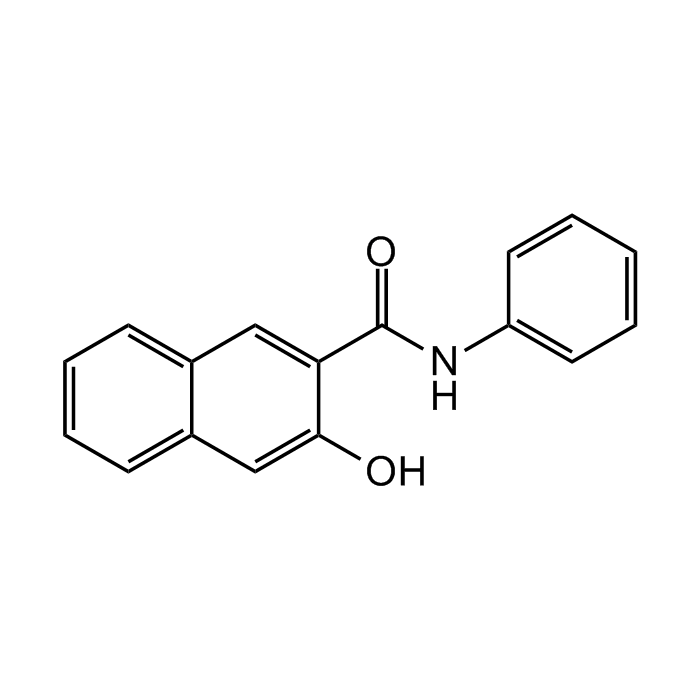Cookie Policy: This site uses cookies to improve your experience. You can find out more about our use of cookies in our Privacy Policy. By continuing to browse this site you agree to our use of cookies.
Chemodex
Naphthol AS

| Product Details | |
|---|---|
| Synonyms | 3-Hydroxy-2-naphthanilide; Azoic Coupling Component 2 |
| Product Type | Chemical |
| Properties | |
| Formula | C17H13NO2 |
| MW | 263.3 |
| CAS | 92-77-3 |
| RTECS | QJ1897400 |
| Source/Host Chemicals | Synthetic |
| Purity Chemicals | ≥99% (HPLC) |
| Appearance | White to off-white powder. |
| Solubility | Soluble in EtOAc. Slightly soluble in methanol. |
| Identity | Determined by 1H-NMR. |
| Declaration | Manufactured by Chemodex. |
| Other Product Data |
Click here for Original Manufacturer Product Datasheet |
| InChi Key | JFGQHAHJWJBOPD-UHFFFAOYSA-N |
| Smiles | O=C(NC1=CC=CC=C1)C2=CC3=CC=CC=C3C=C2O |
| Shipping and Handling | |
| Shipping | AMBIENT |
| Short Term Storage | +4°C |
| Long Term Storage | -20°C |
| Handling Advice | Protect from light and moisture. |
| Use/Stability | Stable for at least 2 years after receipt when stored at -20°C. |
| Documents | |
| Product Specification Sheet | |
| Datasheet |
 Download PDF Download PDF |
Naphthol AS (3-Hydroxy-2-naphthanilide) is a fluorescent dye commonly used as a building block or intermediate to produce fluorigenic substrates, bioactive chemicals or as a coupling reagent to produce azo dyes. After cleavage of the fluorigenic substrates by esterases the free Naphthol AS can couple with diazonium salts to form different types of fluorescent azo dyes. 3-Hydroxy-2-naphthanilide (3HNA) is also a naturally occurring chemical that can be found in human urine. It is used as a marker for early pregnancy.
(1) B.L. Kaul, et al.; Chimia 19, 213 (1965) | (2) M. Hueckel; Text. Chem. Color. 1, 510 (1969) | (3) A. Vaughan, et al.; Anal. Chem. 43, 721 (1971) | (4) D.M. Hall, et al.; Text. Res. J. 50, 692 (1980) | (5) Y. Sumi, et al.; Histochem. 73, 481 (1982) | (6) K.-Y. Lee, et al.; Dyes Pigm. 23, 243 (1993) | (7) S. Fujita, et al.; Anal. Chem. 66, 1347 (1994) | (8) C. Daescu & D. Hadaruga; Dyes Pigm. 40, 235 (1999) | (9) V.A. Vaillancourt, et al., Bioorg. Med. Chem. Lett. 10, 2079 (2000)





